
With vacations and visitors on hold this winter, we teamed up with The Home Depot Canada to create the ultimate fun at home – a really easy DIY outdoor skating rink right in our very own yard! The Home Depot Canada has been our go-to for all of our pandemic project needs, and this was no different – we were able to get everything we needed for our skating rink at our local Home Depot location* and having a skating rink in our yard has been a total blast. Thank you, The Home Depot Canada for sponsoring this post.
Oh my goodness…. I can’t even tell you how much fun we’ve been having with this little DIY outdoor skating rink we put together in our front yard! Any time we like, day or night, we can just whip on our skates, head outdoors, and enjoy a little ice time without even having to leave home. It’s truly been the BEST way to make it through our recent cold snap – we get outdoors every day and it’s actually really enjoyable. The kids have loved it too and they’ve both become better skaters because of it.
A fun fact? Growing up, my dad, along with a few other neighbourhood parents, used to flood our local park in good ol’ Cold Lake, Alberta to create a skating rink for us kids, so the whole process has been very nostalgic for me. I think many of our lovely retiree neighbours have felt the same way because throughout the process they’ve been cheering us on, stopping to chat about it, giving us tips, asking to take photos of us, and even dropping off treats to enjoy with our hot cocoa afterwards…. So sweet!

Now here’s the thing about this particular DIY outdoor skating rink…. It’s incredibly easy to put together! I know because I’m not all that handy, I have a very limited tool stash, and I put this together myself with just a little bit of help. And truth be told, I could have built it completely on my own if need be, but my brother dropped by just to check in (he’s been a builder and project manager for his entire adult life and he’s who I consulted while drawing up my plans) and because he can’t bear to stand around, he jumped in and sped the process along part way through. He made sure not to do any job I hadn’t already done myself though, so I truly got a chance to do at least part of every task required to create our rink.
If you’ve ever considered making one, I highly recommend giving it a shot. I promise it’s doable and it’s a fairly affordable project too – especially given the fact that the wood and tarp can be used year after year.
Yours will look slightly different based on the space you’re working with of course, but here’s a detailed look at how I made our DIY outdoor skating rink…

1. First, I started by sketching out some plans. To do so, I went out into our yard, determined which space seemed largest and flattest, and then measured it so I knew what I was working with. Our total space was approximately 26 by 24 feet, so I decided to make our rink 24 by 22 feet just to give some space along the edges.
I decided to enclose our rink the simplest way possible – with a perimeter of 2×6 boards, plus additional 6-foot 2×6 boards at the joint on each side to ensure they were nice and strong. In order to hold the boards upright, I chose to use wooden stakes every few feet, so I used that info to draw up my plans. As you can see from my sketch, I thought I’d use L-brackets on the inside corners of my frame too, but once we got building we realized that they weren’t really necessary, so we skipped them!
Just for fun, I decided to include a simple bench and some posts for hanging string lights (string lights make everything better, don’t they?!), but those are totally optional. If you want minimize work and cost, I’d totally skip both!
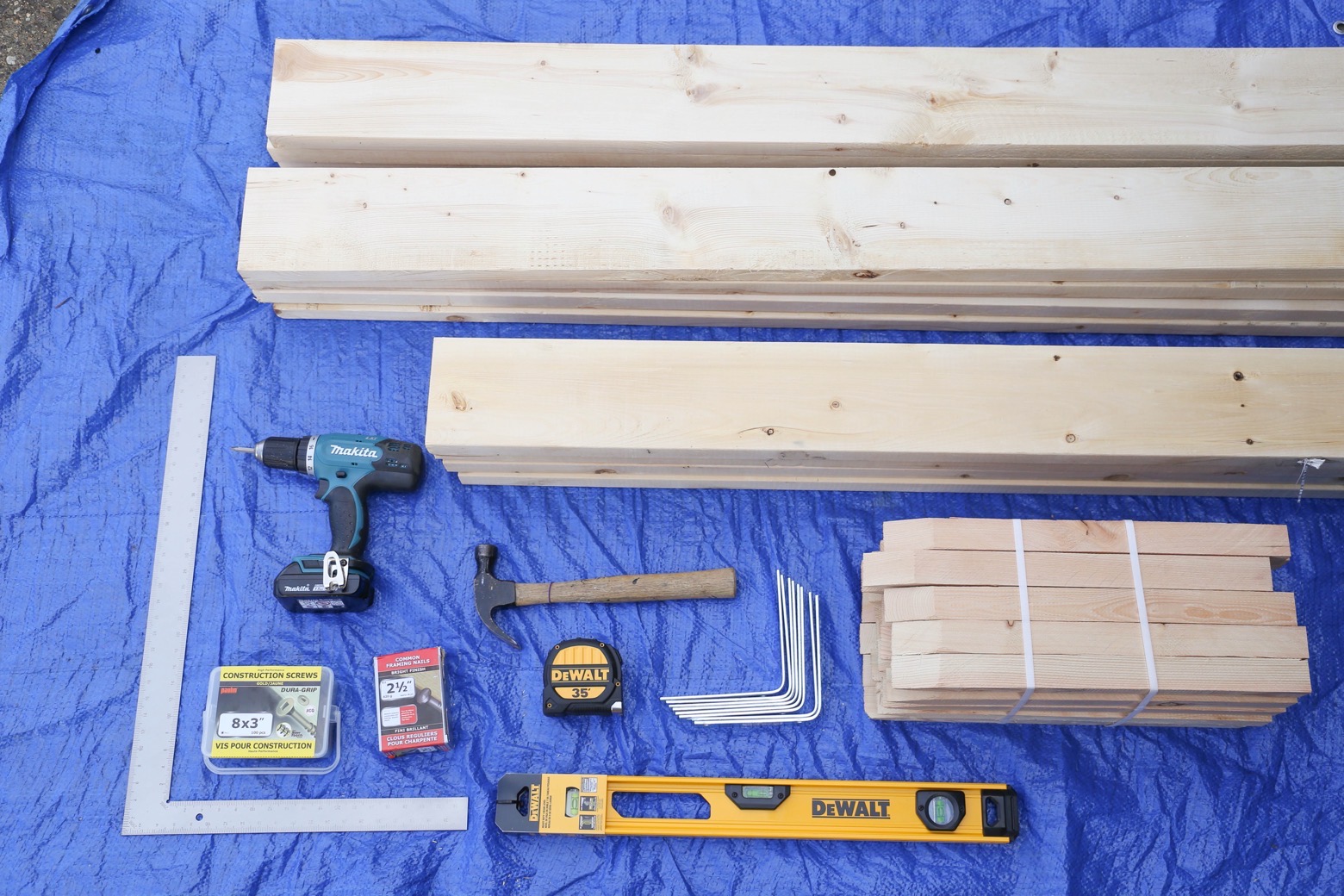
As far as materials go, I picked up every single last thing at our local Home Depot Canada store, which definitely added to this project not being overly complicated or time consuming. (Isn’t being able to get every item on your list in one stop the very best?!) The other thing I love about The Home Depot Canada? They’ll cut all of your wood for you for a very minimal fee! Such a game changer if you’re like me and don’t own an actual saw… All you have to do is go into the store with your lengths planned and they’ll take care of the cutting for you. (Yes please!). Another option? Trying their tool rental service!
Okay, here’s everything I used for the project…
For the rink frame:
– ten 12-foot 2×6 boards
– two 8-foot 2×10 boards
– one 25-pack of 2×2 pointed wood stakes
– two 100-piece containers of 3-inch construction screws
– 30-feet x 50-feet all-purpose white tarp
For the lighting:
– twelve 8-foot 2×4 boards
– six 1 1/4 inch hook 2-packs
– two 48-foot plug-in LED string lights
I also used the following tools / equipment:
– carpenter’s square
– level
– sledge hammer
– line reel
– measuring tape
– power drill & bits
– hose

2. With my plan in place and my materials picked up, it was time to build our skating rink frame. This was a job I wanted to do quite early while it was still warmish and the ground wasn’t yet frozen. (I’m sure you could probably do it in colder temps if needed, but the stakes would be harder to pound into the ground.) To start, I set out my materials on the lawn exactly as I wanted the rink to be. This included my long 2x6s, my shorter support 2x6s, and my wooden stakes.
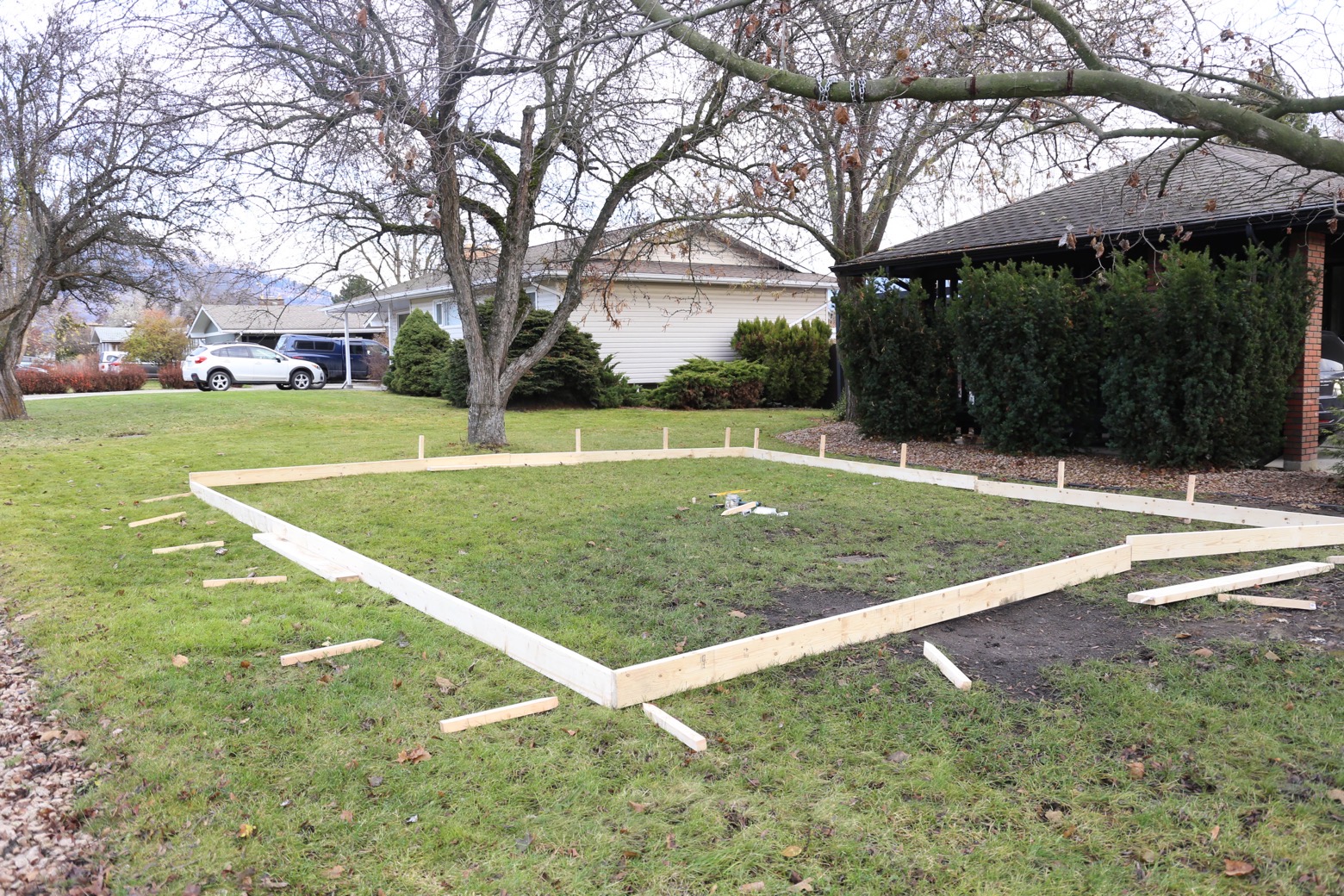
Standing the 2x6s up on their sides is tricky when they’re on uneven ground, but I just laid them down or tapped in a some stakes where needed.

3. Next up, we attached the two long 2x6s that formed each side of the rink frame using the shorter support 2x6s. This meant that we now had 4 very long pieces – our 4 sides of the frame.
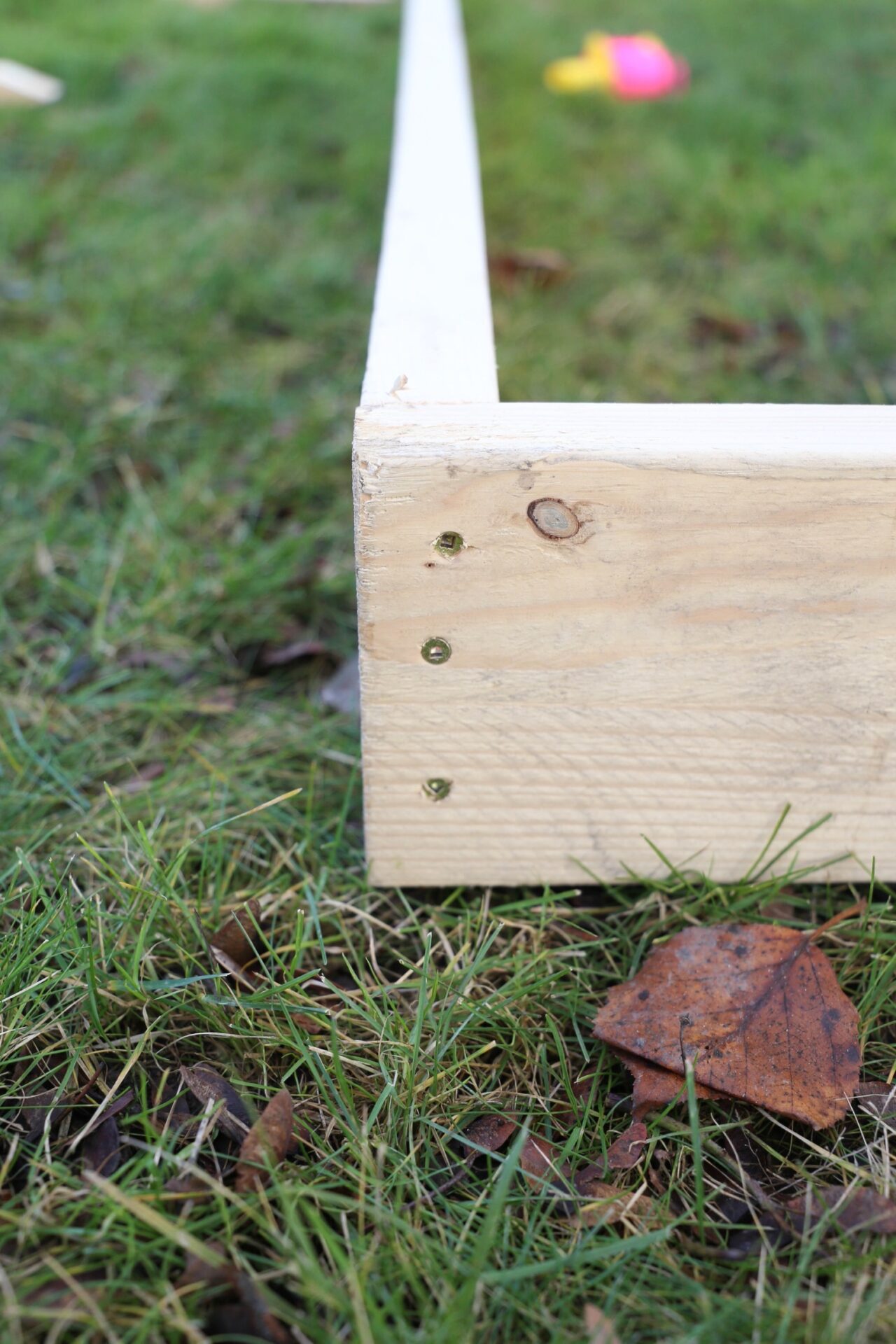
4. With that, it was time to connect our first corner. Using a carpenter’s square to make sure we had a decent right angle, we screwed our first corner together.

5. Okay, this next part is kind of important if your space is like ours and isn’t all that level. First, determine your surfaces’s high point. For us, this was just to the right of the patch of soil you see in this pic. Your 2×6 frame will sit directly on the ground at the highest point and will sit up off the ground at lower points.
Make sure your corner and attached sides are situated as you want them, then pound a stake into the ground on either side of the corner. Place your level on top of your frame somewhere in between your high point and your corner and lift your corner until it’s completely level. If you have someone to hold it in place for you, fantastic, but if not, you can prop it up with some scrap wood or even your foot / leg (safely of course!) while you screw through your stakes and into frame. If your first corner is lower than your high point like ours is, it’ll sit up off the ground.
6. Next, screw together your remaining corners. Don’t worry too much about having a perfectly rectangular rink at this point – you just want to kind of get everything tacked together.

7. Okay, now to try and get everything nice and square! Honestly, I don’t know important this is beyond how it looks, but we aimed to get it as square as possible using this set up – a reel line run from the original corner to the next one over, plus a measuring tape from corner to corner diagonally.
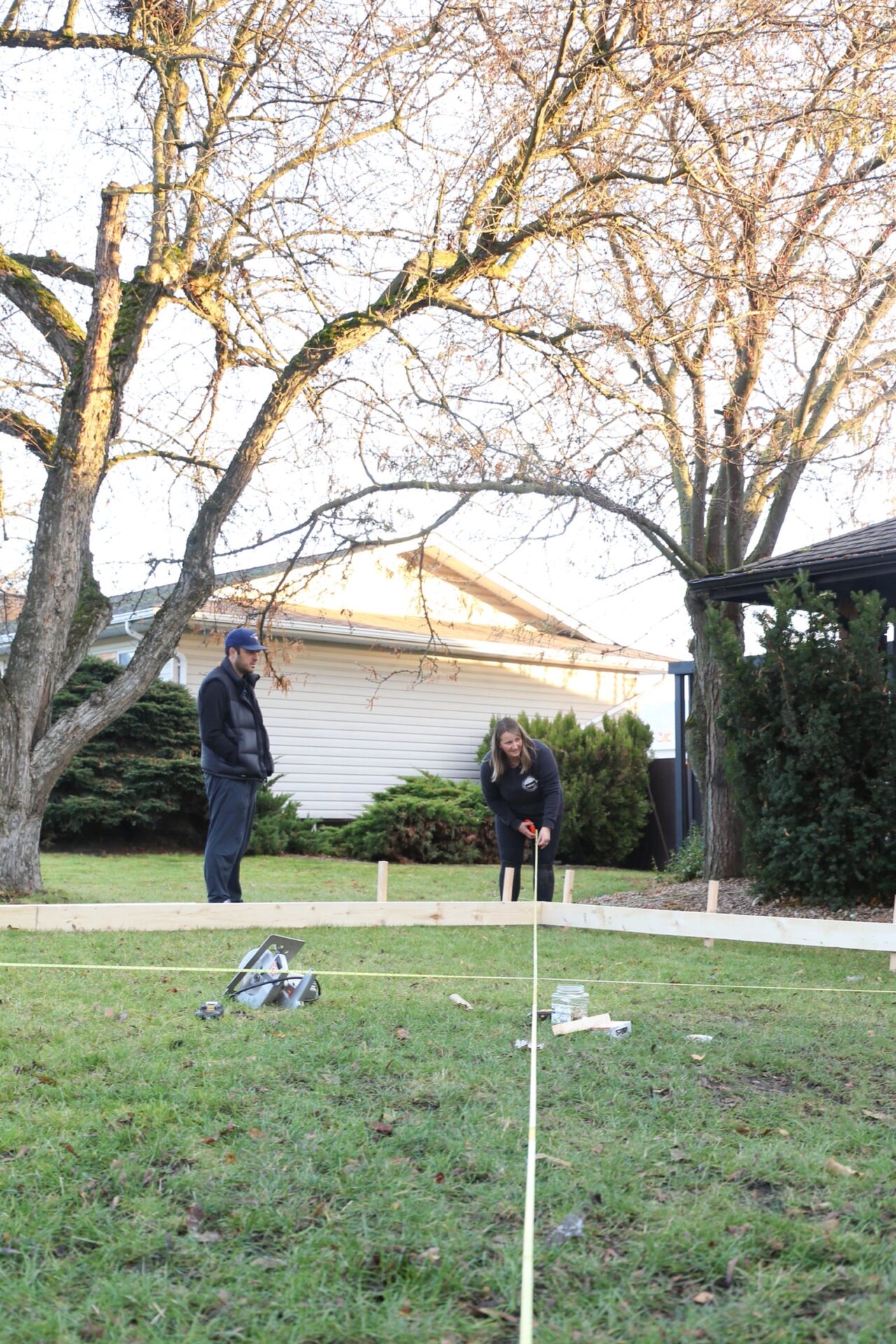
My brother actually ended up having two really long tape measures with him, and we found that running them both diagonally at the same time (so they form an ‘x’ in the middle of the rink) was the way to go. Basically you want to place the boards so that the two corner-to-corner measurements are as equal as possible and so your long sides follow the path of your line reel (it’s surprising how off it can be). When we started, our rectangle was far from perfect, but we just kept measuring and shifting our boards / corners until it was good.
8. When your rink frame is nice and square, begin driving in your other stakes, placing one on each side of every corner and then one every few feet or so in between the corners. Just as you did before, attach your frame to the stakes securely using your level along the way. In some places your frame might be resting on the ground and in others it might be a ways off the ground – the most important part is that it’s as close to level as possible.
If you’re just doing a basic frame with none of the extras, you’re done for now! YAY!! You’ll want to hold off on laying your tarp until you’re ready to start making ice, so don’t worry about that just yet. If you’re wanting to make a bench and light posts like I did, stick with me for just a bit yet!

9. Okay, time for our very basic bench! I figured this might be nice for taking breaks, putting on and taking off skates, and sipping on hot cocoa, and I was totally right. Our bench actually gets used a ton, so I’m glad I made one.
To make it, I used one long 2×10 and got my friends at Home Depot Canada to chop it into four pieces for me – one long piece for the bench top and three equal shorter pieces for the legs. I assembled it just like you’d imagine…. By placing one leg on either end of the bench and the other one directly in the middle. Then I simply screwed down into the legs from the bench top. (I should have taken a picture of it before we attached it, but just imagine a giant ‘E’ flipped onto its side and you’ve got the idea – hah!)

10. For stability, attach your bench directly onto the frame of your rink.

This side is by far the lowest side of our front yard, so as you can see, our frame is sitting up off the ground a good amount. For this reason, I made sure to make my bench legs extra tall, but you’ll make yours to suit your space of course.

At this point, it was starting to look like an actual outdoor skating rink, wasn’t it??

11. Next job – attaching the light posts! Originally I wanted to use 2x2s for this job simply for the sake of looks, but my brother suggested that 2x4s might be better stability wise, so that’s what we went with. I decided to use 12 6-foot tall 2x4s evenly spaced around the perimeter of my frame and recruited my littlest helper for the job.

To attach them, we simply made sure that the bases of the 2x4s were flush with the base of the frame, checked that they were level, and then screwed them into the frame with several screws.

While we were at it, we decided to add another 2×6 to the bench side of our frame in order to close in that big gap we had. If the gap were smaller I wouldn’t have bothered, but I went ahead with it since this side of the yard is so much lower than the rest and I figured it would be helpful to have that barrier in place when flooding.
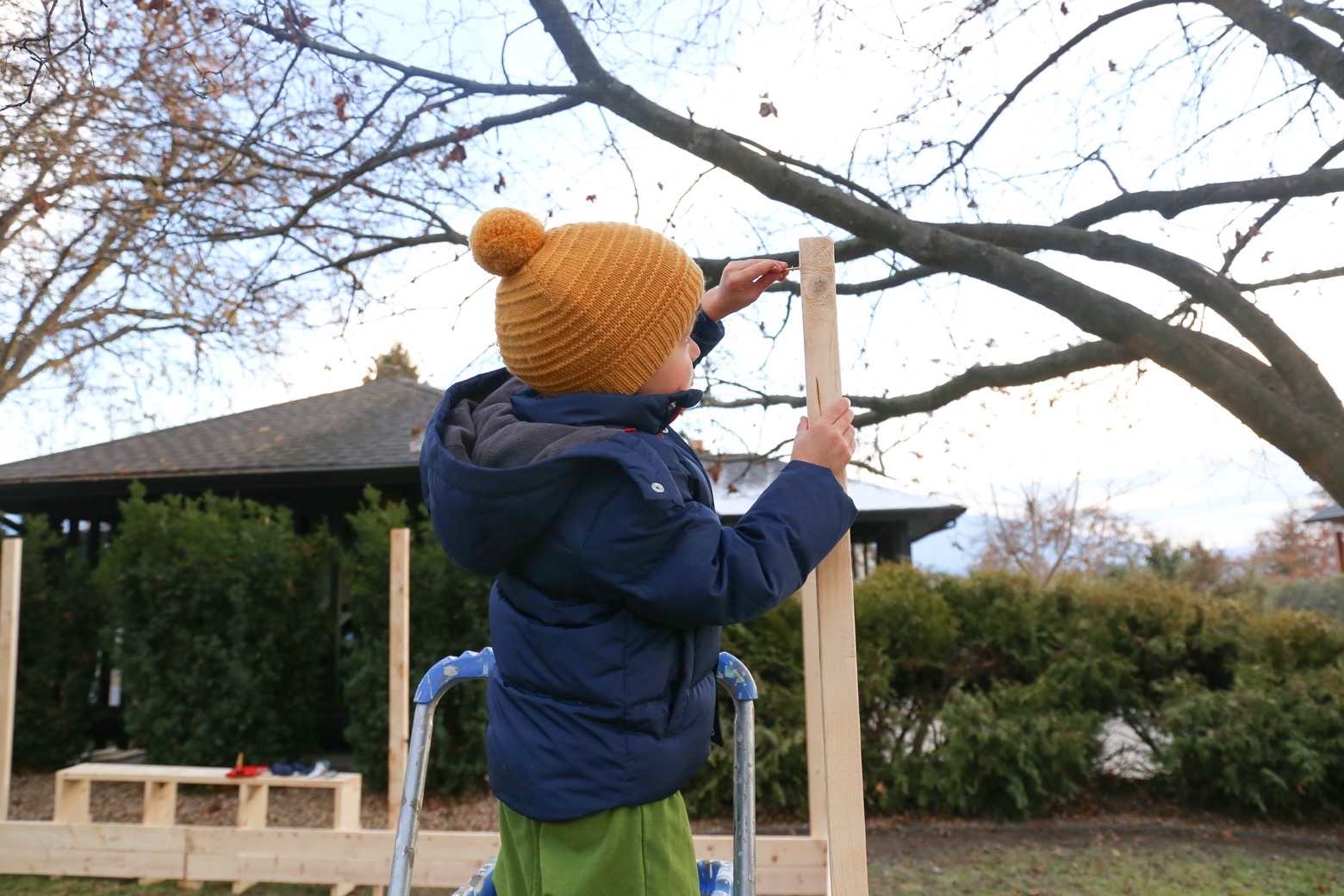
12. As our final step in constructing the actual rink structure, Sam and I added little screw-in hooks to the tops of our light posts…

And our skating rink structure was officially complete!

And then it was basically a waiting game….
One thing we did do as we waited for freezing temperatures was that we used the snow we shovelled from our driveway to fill in our low side of the rink and make the ground more even. Now truth be told, it all melted before our weather got cold enough to make ice, but it was worth a shot and I do think it would have been helpful had it turned out. We also strung our lights up, which turned out to be super helpful for evening floods later on.

With everything in place and ready to go, the moment it got cold, we jumped and began making ice! To do so, we set our giant white tarp into the base of the rink (folded in half), pulled it nice and snug, and draped the extra material over the edges of the frame. Then we began adding water using our garden hose. How much water you add at a time is up to you…. We had quite a bit of evening out to do and would usually flood for about 15 to 20 minutes at a time. We’d wait for the water to freeze completely, then add another layer.

Now a few of things to know about the actual ice making process….
First of all, back in the fall we actually had our old outdoor tap replaced with a frost-free outdoor tap to make sure we wouldn’t have issues with it freezing up while trying to use it mid-winter. This was something we wanted to get done anyways, but this project was definitely motivation to get it done asap.
Secondly, and this might be obvious, but it does really need to be cold out. We started trying to make ice the moment our temperatures were consistently at 0º or below both day and night and the process was slowwwwww. Truthfully, I wasn’t sure it was going to happen for us for a little bit there! We’ve had the STRANGEST, most mild weather ever here in the Okanagan and when daytime temperatures started rising above 0º, everything started melting. Thankfully we got a good cold snap and the moment temperatures were consistently at -5º to -10º, making ice was a total breeze!
Thirdly, to avoid having it freeze up on you, you’ll want to take your hose inside with you after each flood. During the ice making process, we kept our hose in a big tote bin, which made it really easy to bring it in and out of the house without any mess.

Keep adding layers until you have a good, solid slab of ice. If needed, I know you can do a final flood with hot water to smooth everything out, but we didn’t need to…. Our ice turned out nice and smooth all on its own!

Once we had the base of our rink completely covered in ice / water, I did loosely tack the excess tarp to the outside of the rink frame with a few screws. I think you could probably skip this step if you didn’t want to put holes in your tarp, but I didn’t mind.

Once your ice is solid, it’s time to skate!!!

And oh my goodness – were we ever excited for this moment!! Because of the timing and weather, our ice making process was slow, but had we started once it was actually cold, it would have only taken us 2 or 3 days from start to finish, which is pretty incredible.
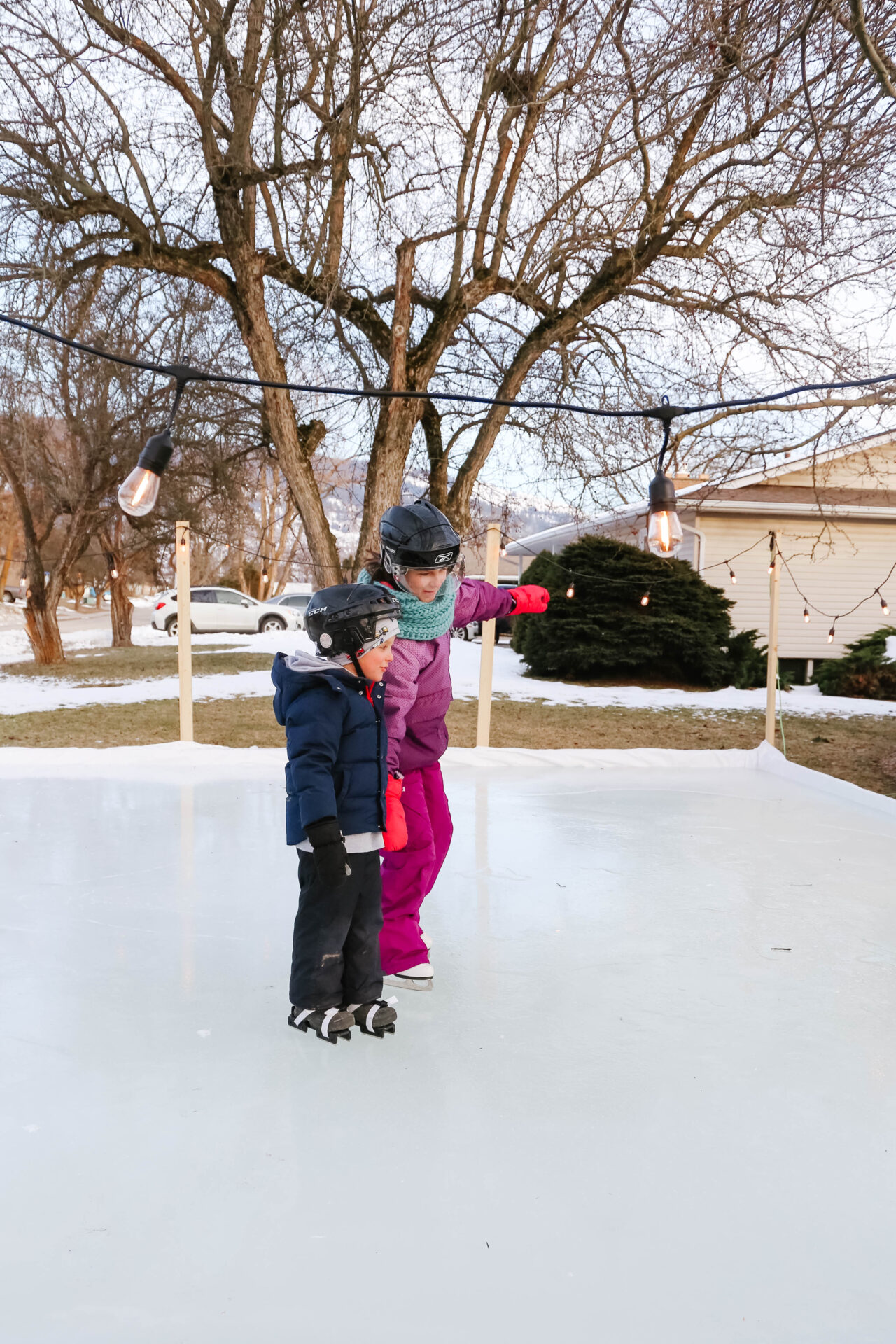
I mean… Does it get any better than this??

Neither of our kids are super confident skaters, but they’ve been enjoying having a home rink SO much and have gotten so much better in just a couple of weeks.

Our favourite thing at the moment? Playing hockey together as a family…
 And enjoying hot cocoa afterwards of course!
And enjoying hot cocoa afterwards of course!

So, so fun. And a definite highlight of this tough, stay-at-home year. I really can’t recommend making your own outdoor skating rink enough.






Leave A Comment